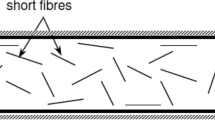Abstract
The rheological properties of fresh concrete, mortar or cement paste are among the most important parameters when cementitious building materials are placed. New material designs, like high or ultrahigh performance concretes, include the addition of a high volume of fibers to the fresh mix influencing its workability properties. However, the analysis of the rheological properties of fiber reinforced cementitious composites is difficult. Conventional methods mostly do not apply, especially when a high fiber content and relatively stiff mixtures are used. For this reason, a new method was developed to evaluate the workability of fiber reinforced composites. This method was applied to carbon and PVA fiber reinforced high performance composites and was used to optimize the rheological properties of these composites for an application in a centrifugation casting process.
Similar content being viewed by others
References
Tattersall GH, Banfill PFG (1983) The rheology of fresh concrete. Pitman Books Limited, London.
Banfill P, (ed.) (1991) Rheology of fresh cement and concrete. E. & F.N. Spon, London.
Ferraris CF (1999) Measurement of the rheological properties of high performance concrete: state of the art report. Journal of Research of the National Institute of Standards and Technology 104: 461–478.
Nawa T, Izumi T, Edamatsu Y (1998) State-of-the-art report on materials and design of self-compacting concrete. Int. Workshop on Self-Compacting Concrete, Kochi, Japan, August, 160–190.
Banfill PFG, Beaupré D, Chapdelaine F, de Larrard F, Domone P, Nachbaur L, Sedran T, Wallevik O, Wallevik JE (Sept. 2001) Comparison of concrete rheometers: International tests at LCPC (Nantes, France) in October 2000, Report NISTIR 6819, National Institute of Standards and Technology, Building and Fire Research Laboratory, ed. Ferraris CF, Brower LE.
Ferraris CF, Martys N (2003) Relating fresh concrete viscosity measurements from different rheometers. Journal of Research of the National Institute of Standards and Technology 108:229–234.
Dilger WH, Ghali A, Rao S (1996) Improving the durability and performance of spun-cast concrete poles. PCI Journal, 41(2):68–90.
Kaufmann J, Winnefeld F (2002) Influence of addition of ultrafine cement on the rheological properties and strength of Portland cement paste. Proc. Int. Conf. Innovations and Developments in Concrete Materials and Construction, Dundee, UK 827–836.
Kaufmann J, Matschei Th, Hesselbarth D (2003) Effect of the addition of ultrafine cement on the properties of fiber reinforced composites. Proc. 11th Int. Conference on the Chemistry of Cement ICCC Conference, Durban South Africa 1683–1691.
Kaufmann J, Winnefeld F, Hesselbarth D (2004) Effect of the addition of ultrafine cement and short fiber reinforcement on shrinkage, rheological and mechanical properties of Portland cement pastes. Cement and Concrete Composites 26:541–549.
Physica Messtechnik GmbH (1999) A new ball measuring system for large particle suspensions. Applied Rheology 9:145–146.
Müller M, Tyrach J, Brunn PO (1999) Rheological characterization of machine-applied plasters. ZKG International 52:252–258.
Tyrach J (2001) Rheological characterization of cementitious building materials. PhD thesis, University of Erlangen-Nürnberg, 2001 (only available in German).
Schatzmann M, Fischer P, Bezzola GR. Rheological behavior of fine and large particle suspensions. Journal of Hydraulic Engineering-ASCE 129(10):796–803.
Zhou X, Li Z (2005) Characterization of rheology of fresh fiber reinforced cementitious composites through ram extrusion. Mater. Struct., 38:17–24.
Hesselbarth D, Kaufmann J (2004) The role of fine supplementary binder in high performance fiber reinforced cementitious composites, 8th Canmet/ACI Int. Conf., SP-221 on fly ash, silica fume, slag and natural pozzolans in concrete, Las Vegas, pp. 395–402.
Kaufmann J, Hesselbarth D, Moser K, Terrasi GP (2005) Application of fiber reinforced high performance composites in spun-cast elements. Materials and Structures 38:549–555.
Nehdi M, Mindess S, Aïtcen P-C (1998) Rheology of high-performance concrete: effect of ultrafine particles. Cement and Concrete Research 28:687–697.
Peled A, Akkaya Y, Shah SP (2000) Parameters related to fiber length and processing in cementitous composites. Mater. Struct., 33:515–524.
Peled A, Bentur A, Mobasher B (2004) Pulltrusion versus casting processes for the production of fabric-cement composites. Proc. Sixth int. RILEM Symp. BEFIB, pp. 1495–1504.
Author information
Authors and Affiliations
Rights and permissions
About this article
Cite this article
Kaufmann, J.P., Winnefeld, F., Hesselbarth, D. et al. Evaluation of the consistency of fiber reinforced cementitious composites. Mater Struct 39, 645–654 (2006). https://doi.org/10.1617/s11527-005-9016-5
Received:
Accepted:
Published:
Issue Date:
DOI: https://doi.org/10.1617/s11527-005-9016-5




